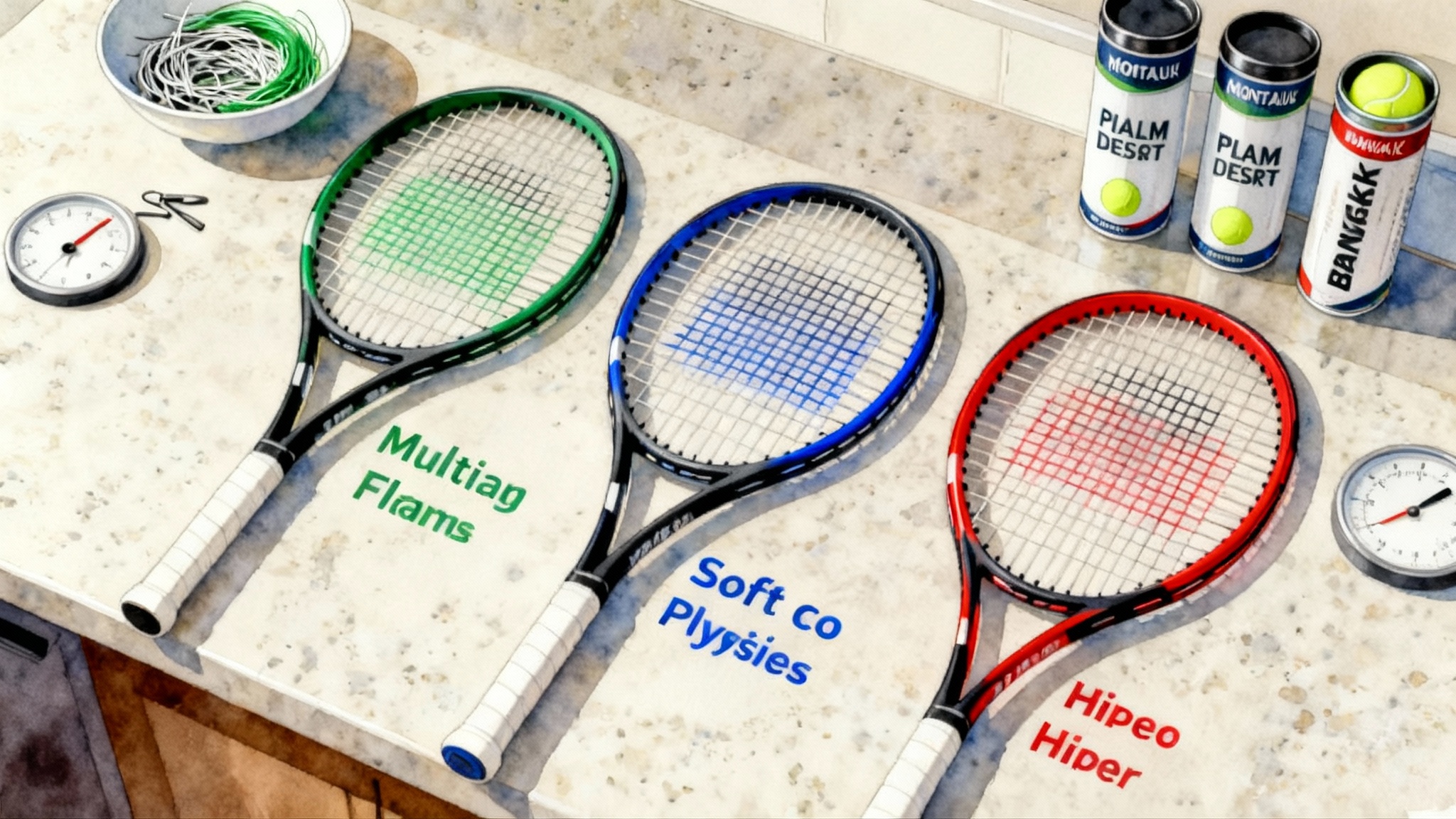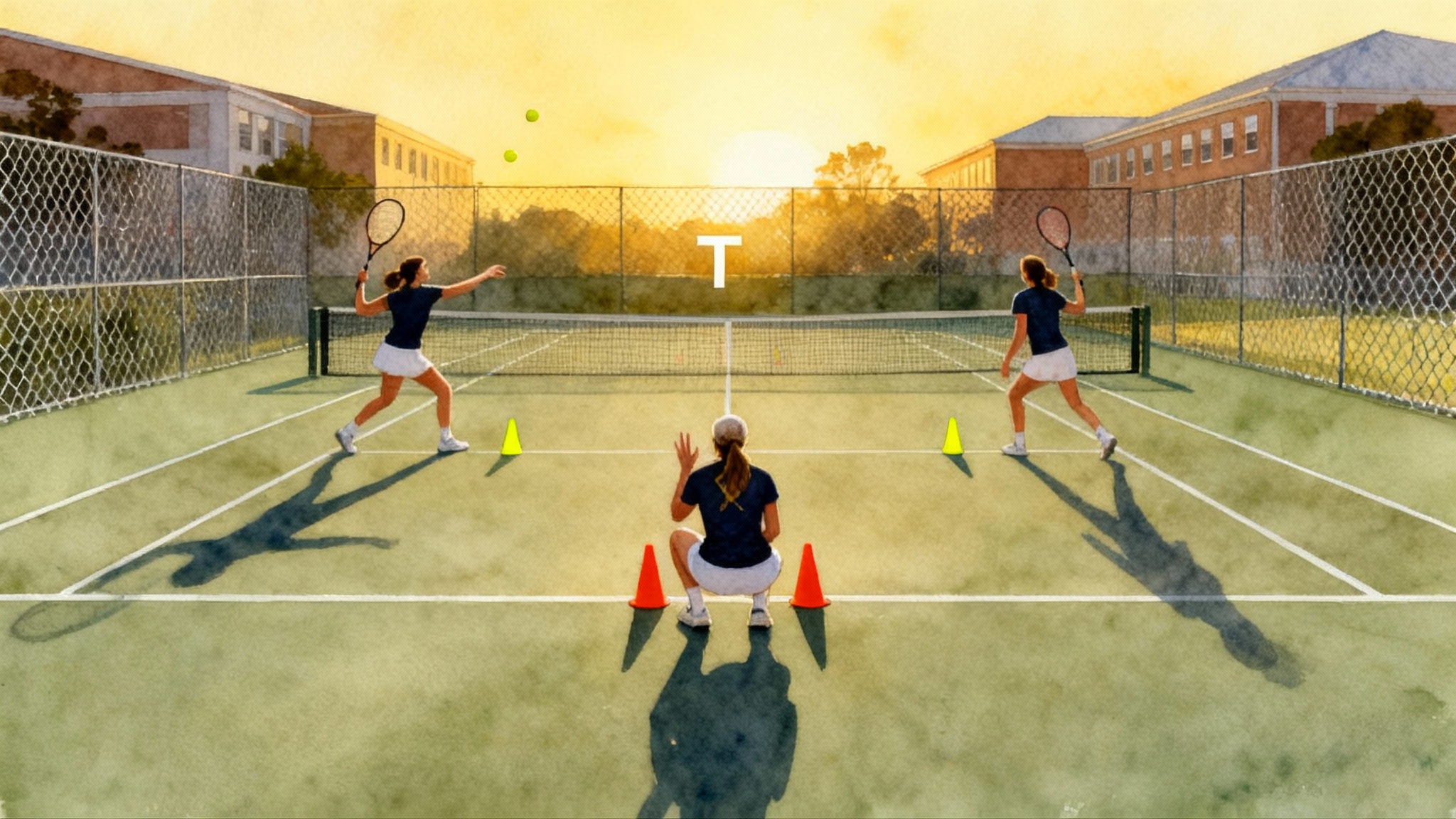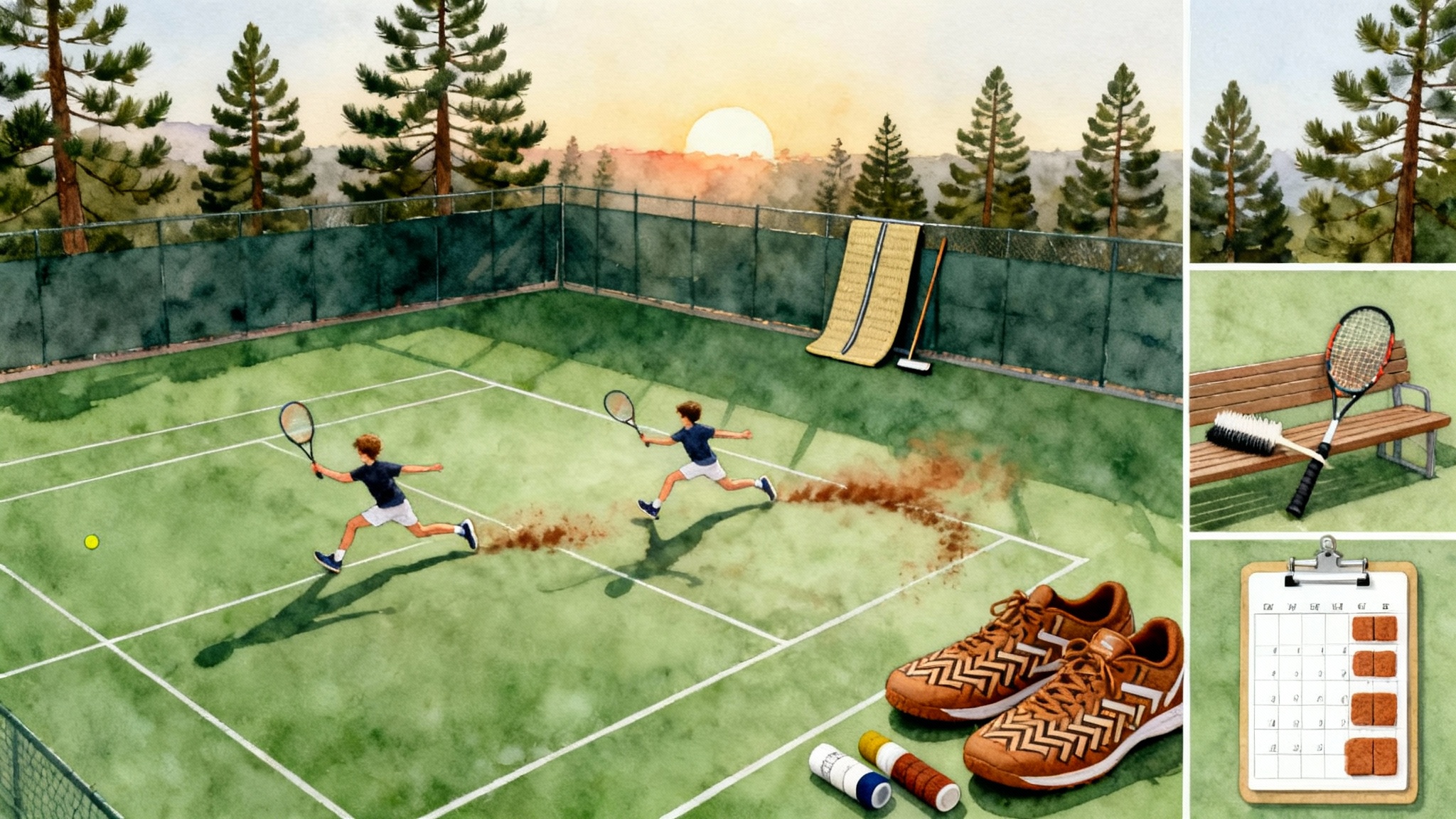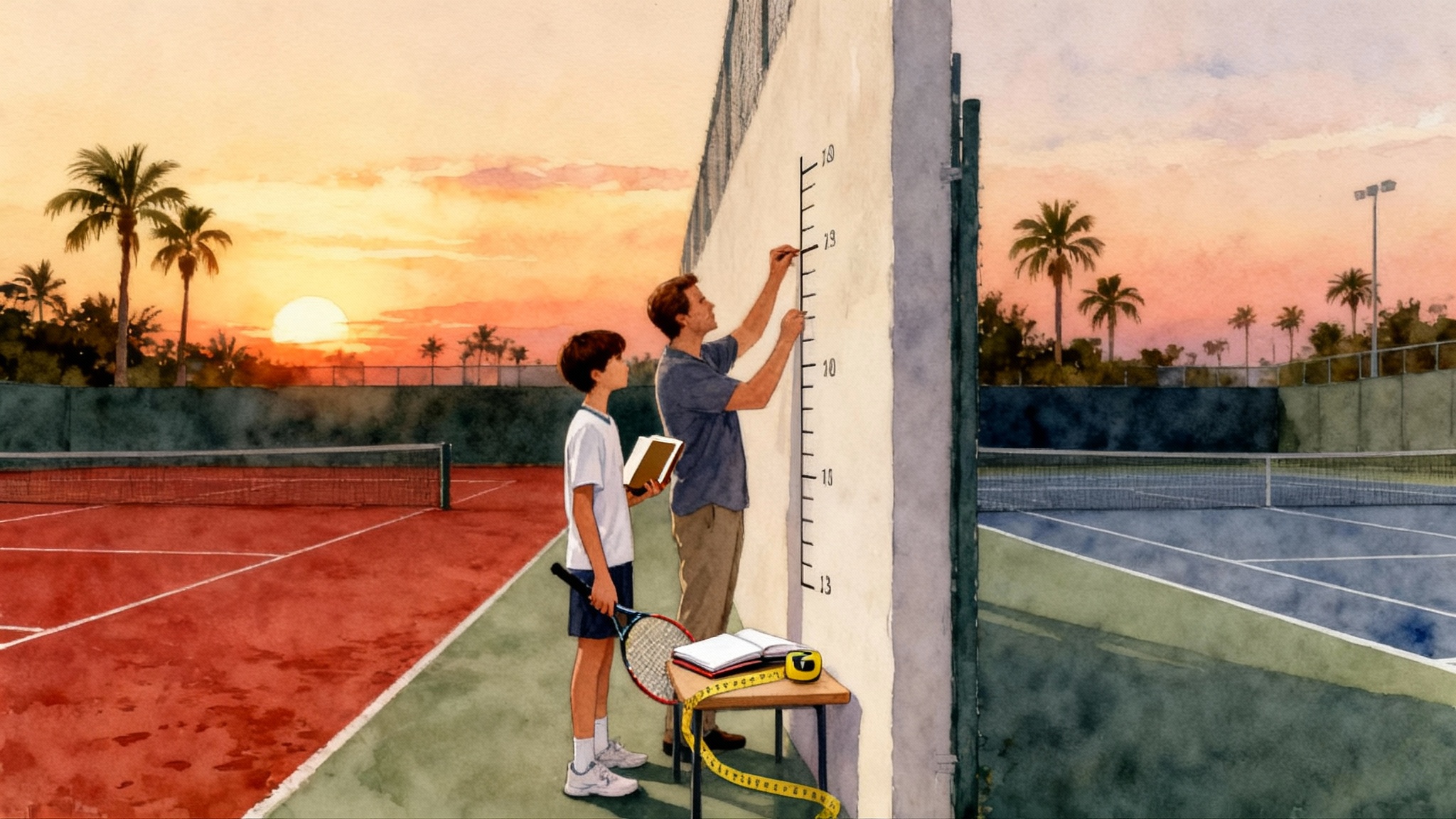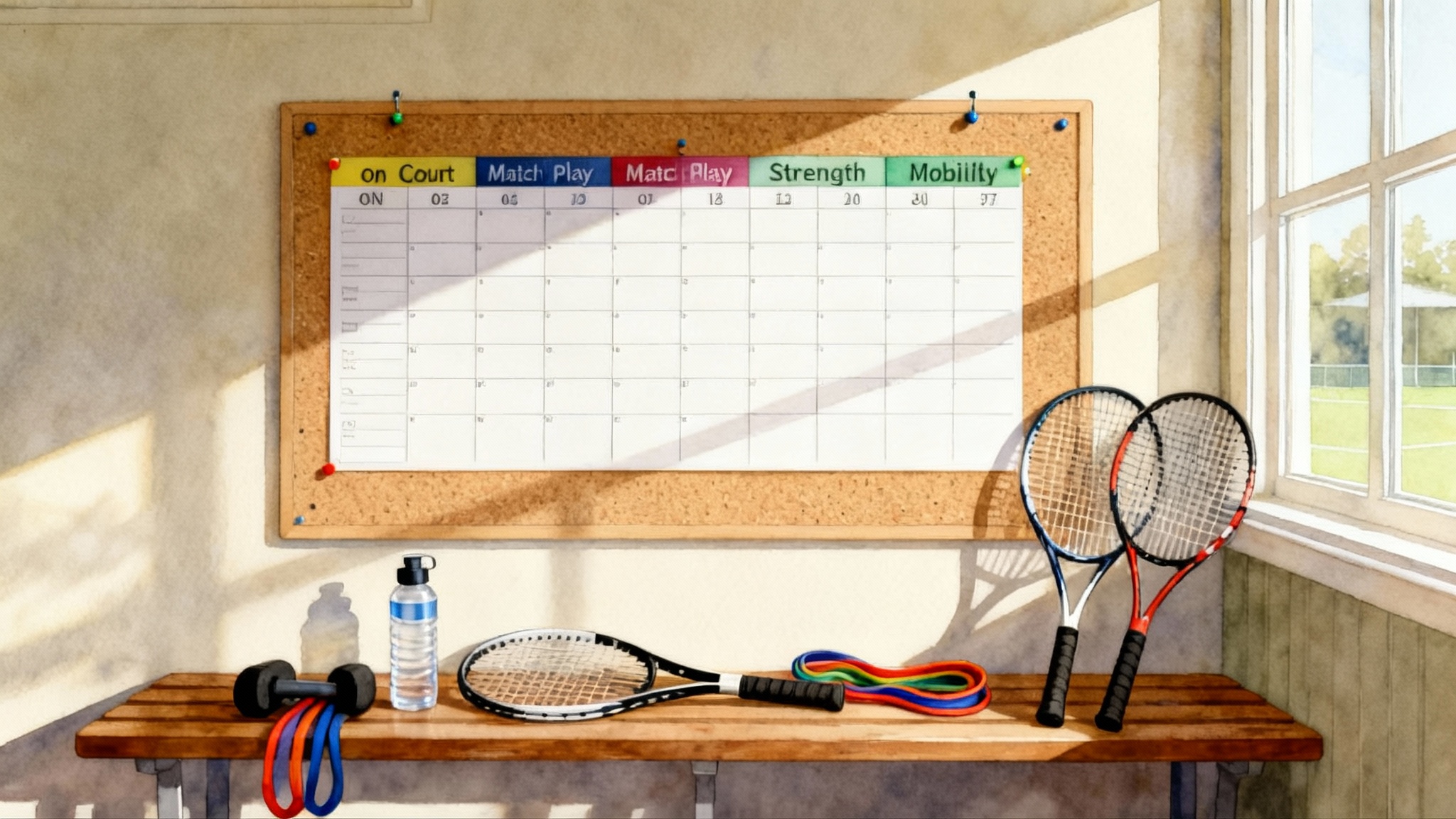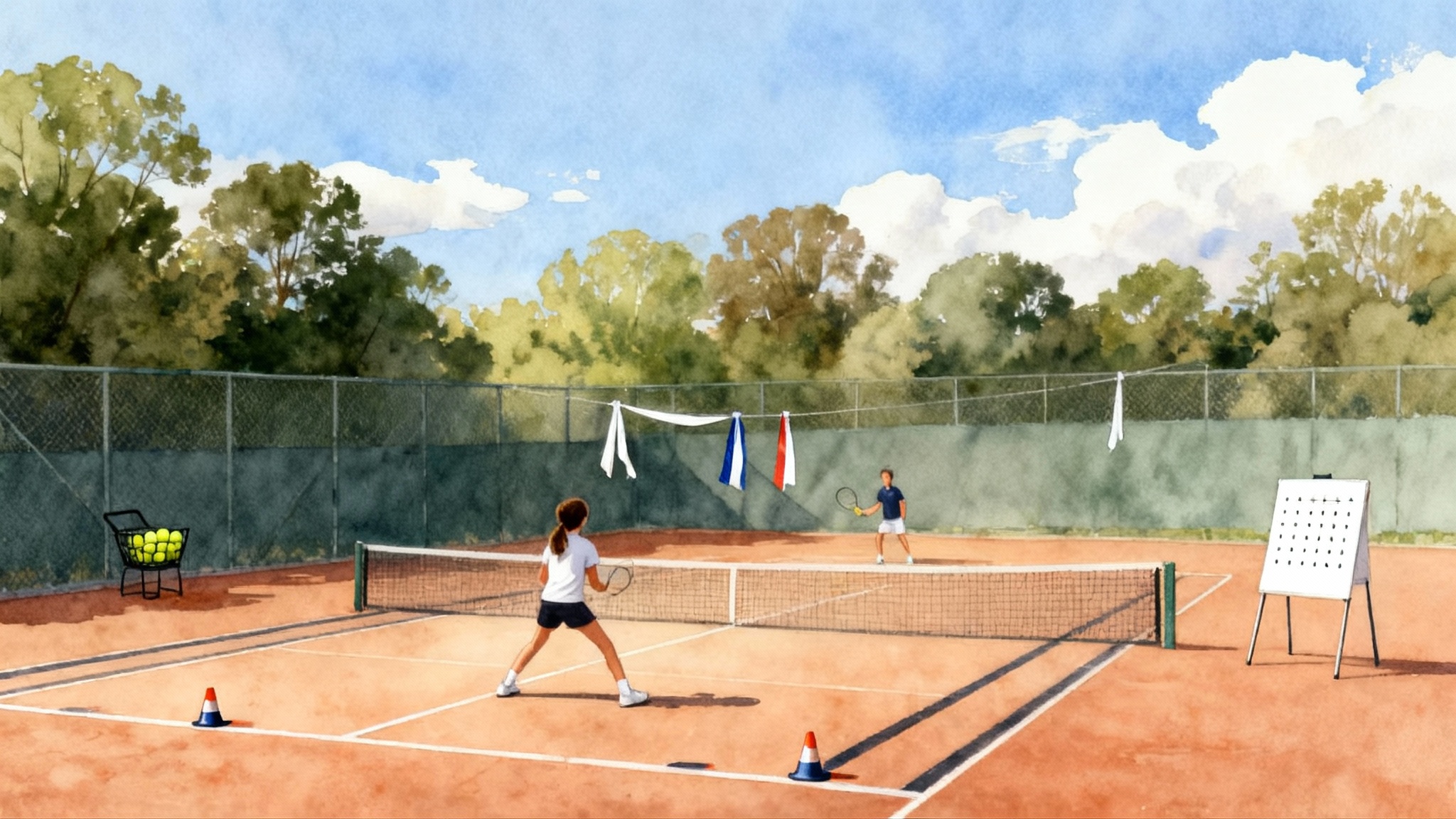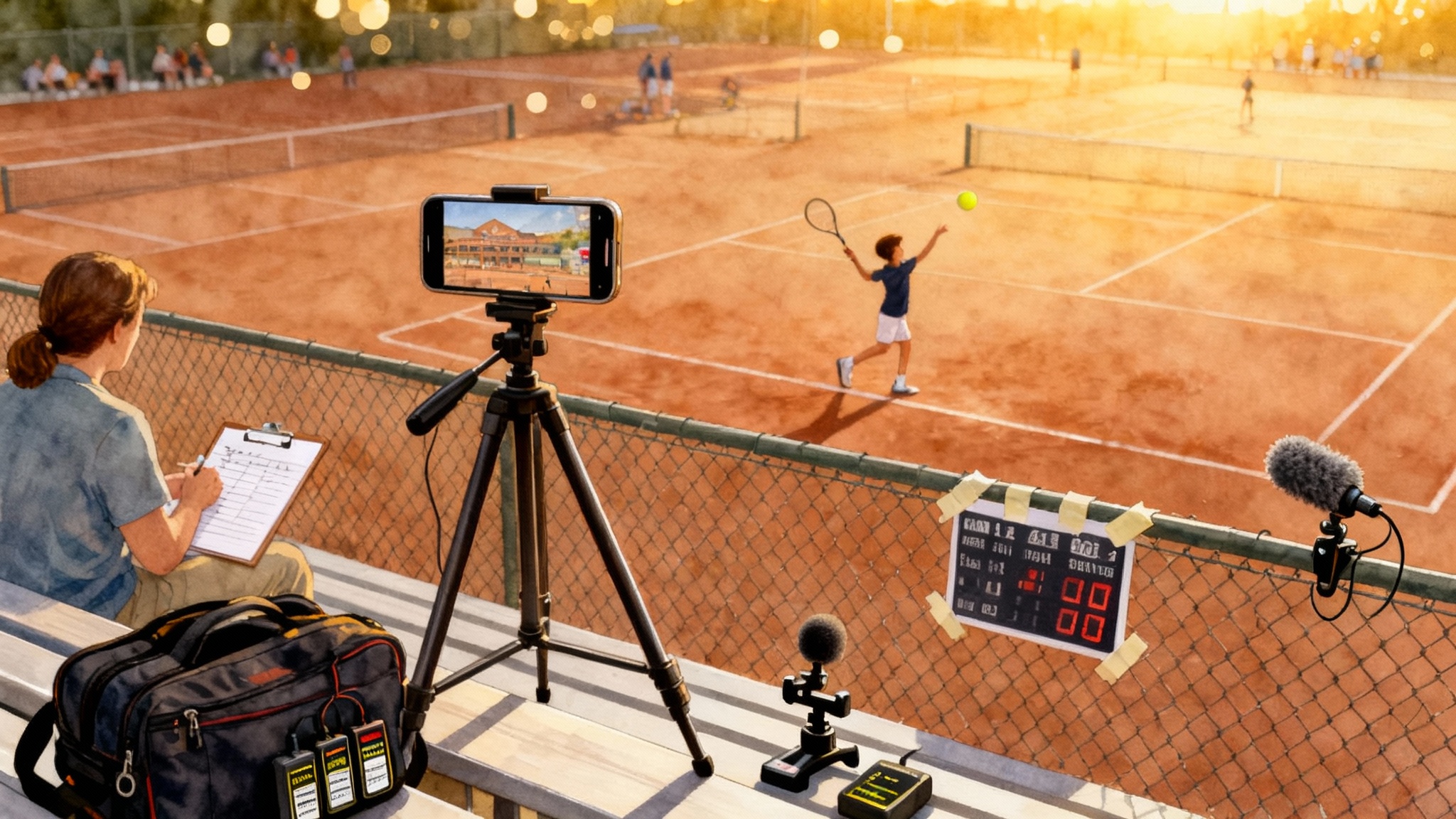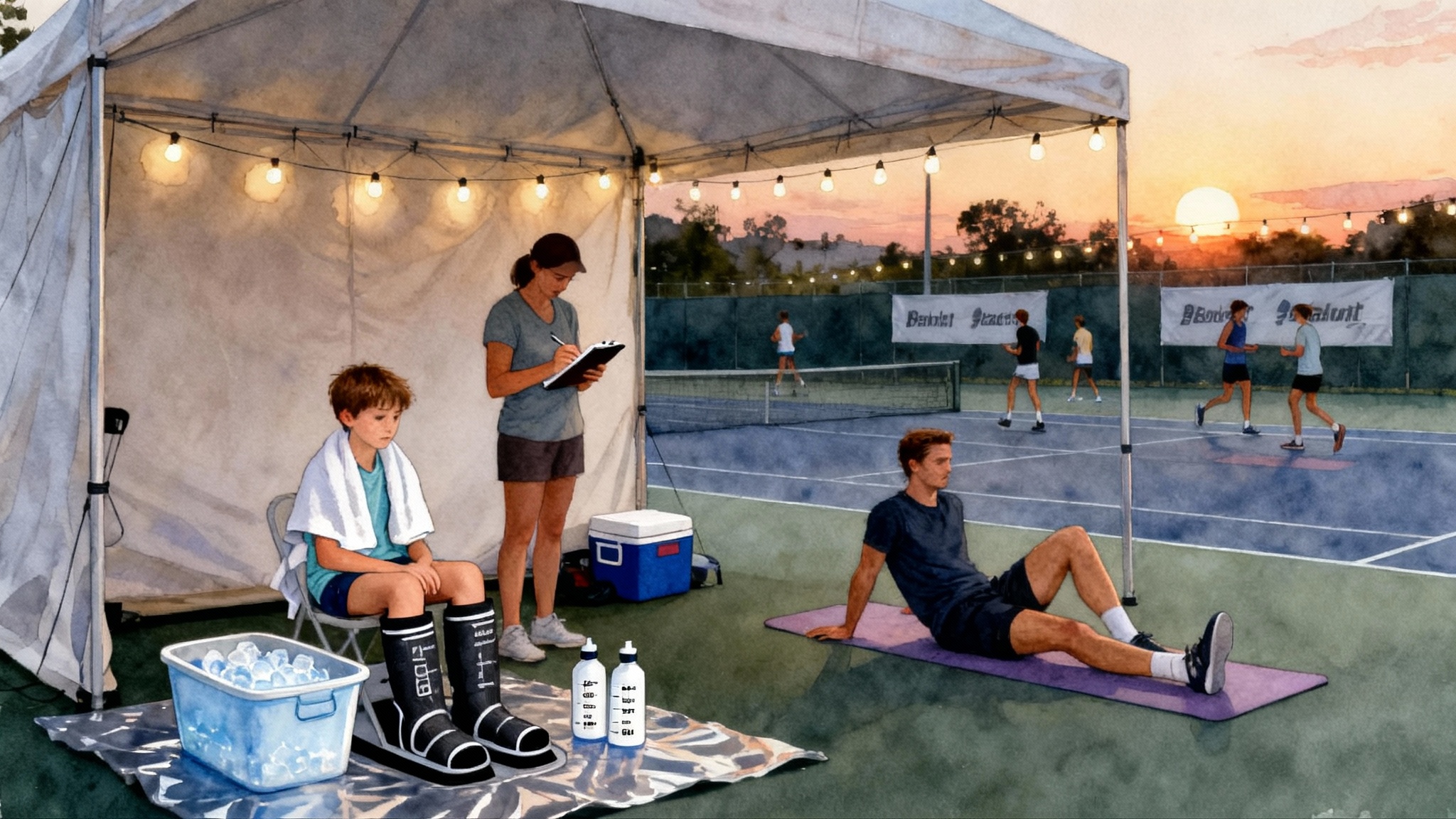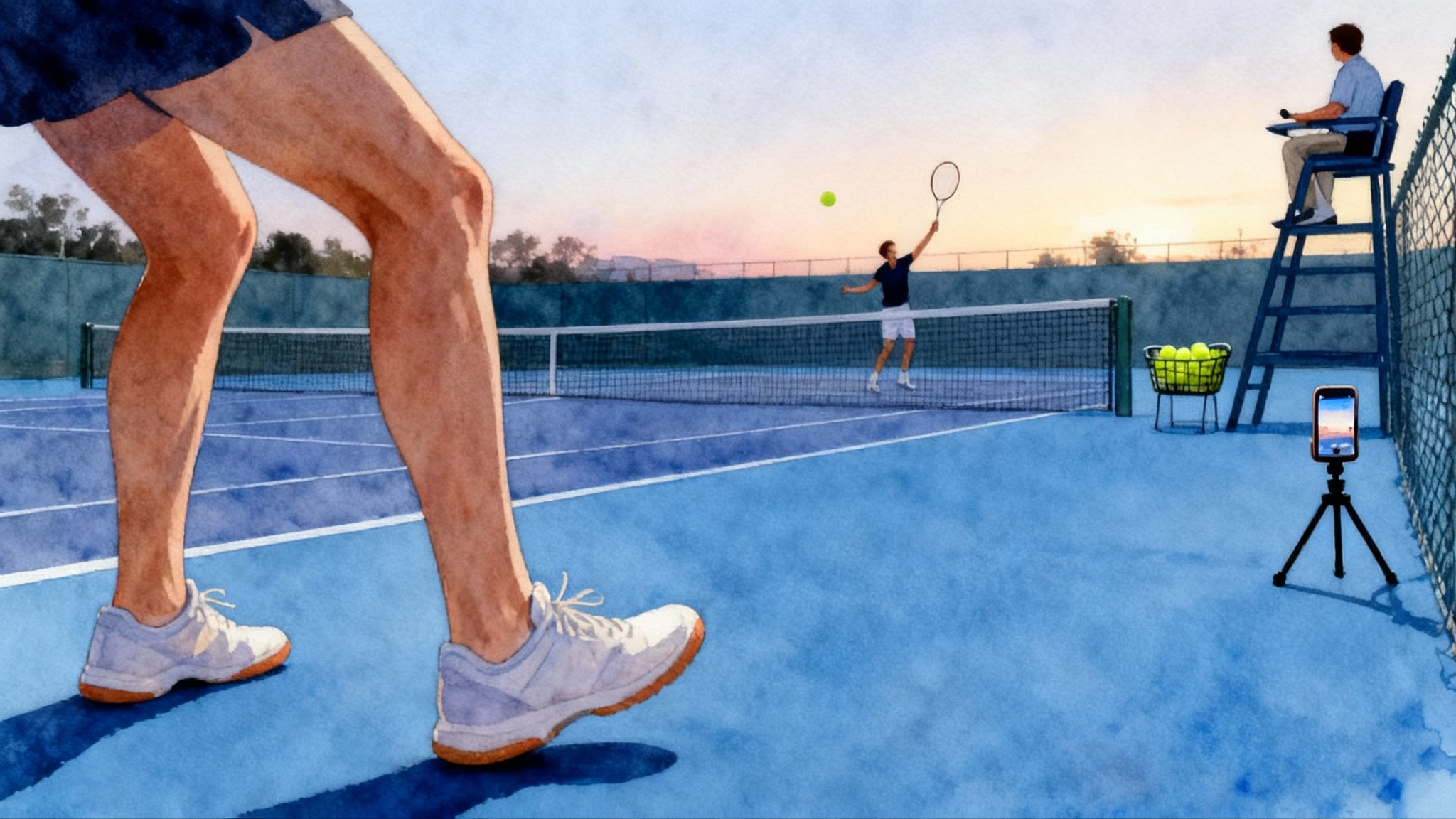Return of Serve Mastery: A 4-Week Plan for Juniors and Adults
Want a faster, cleaner return of serve? Use this four week plan to master split step timing, read the toss and contact, and run simple first ball patterns. Includes junior, parent, and adult tracks with benchmarks and drills.
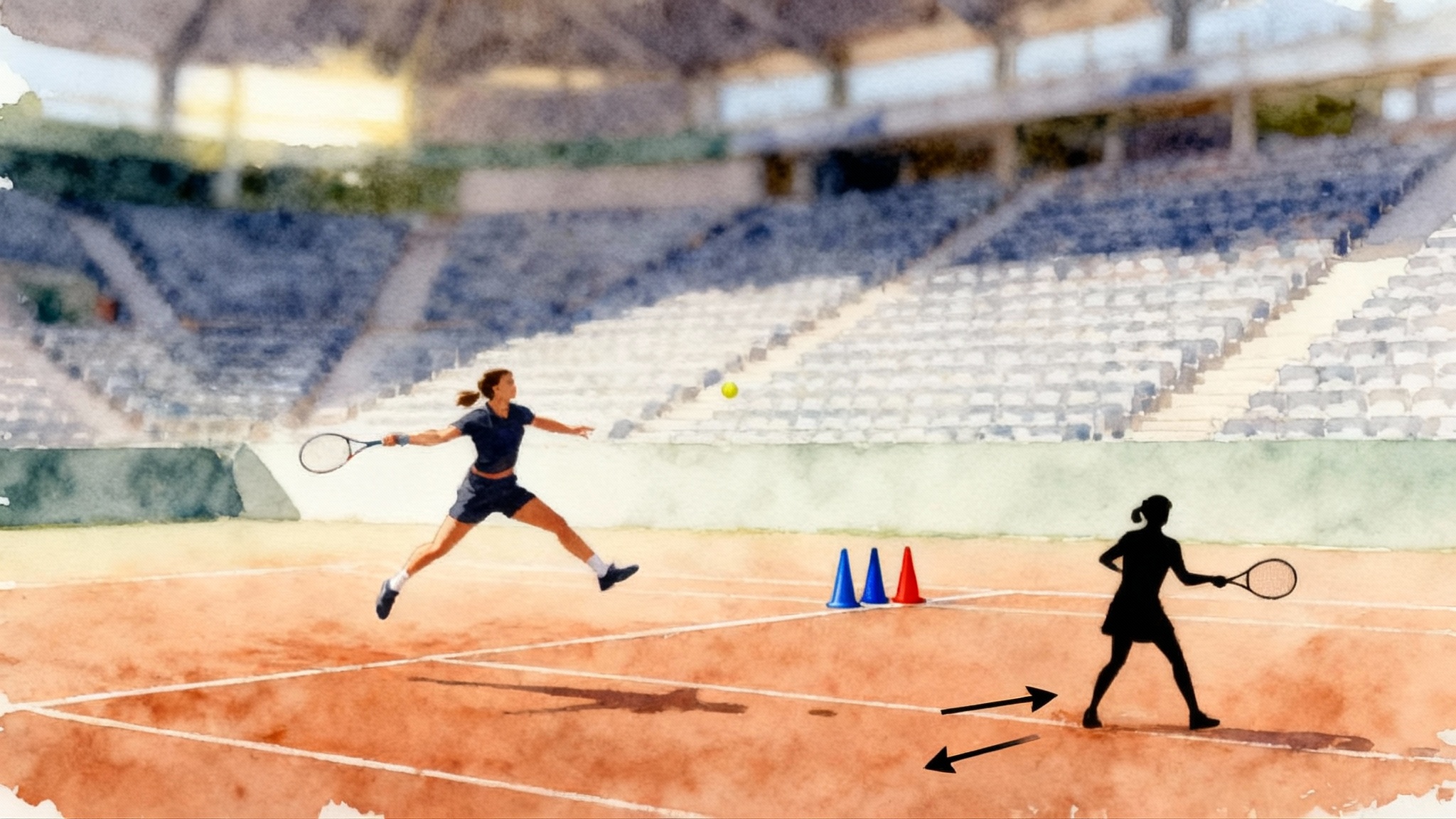
Why the return deserves a plan
The serve gets the spotlight. The return quietly decides momentum. If your return is late, shallow, or predictable, the server controls the point before you swing a second time. A good returner does three things well: times the split step, reads the toss and contact, and knows exactly where to go next. That last piece is the first ball pattern, the simple sequence you run right after the return.
This article gives you a four week improvement plan with clear benchmarks you can track on any court. It includes junior, parent support, and adult tracks, plus plug-in examples you can use in sessions at Lakeland Academy of Tennis and SHOQ Tennis Academy. When you finish, lock in your progress with a coached assessment by booking a session at a partner academy.
The four week overview
- Week 1: Split step timing you can trust under real pace
- Week 2: Reading the toss and contact point so you move first, not second
- Week 3: Contact quality and depth control using simple zones
- Week 4: First ball patterns that simplify choices and raise make rate
Benchmarks you will track every week:
- Make rate: returns in the singles court divided by total returns. Track first and second serves separately.
- Depth zones: use three zones. Zone 1 short (inside service boxes). Zone 2 middle (between service line and three feet from the baseline). Zone 3 deep (land within three feet of the baseline or beyond). Count how many returns land in each zone.
- Direction spread: percentage crosscourt, down the line, and middle.
- Pattern win rate: percentage of points won when you run a named first ball pattern.
Week 1: Nail the split step timing
Goal: land your split step as the server makes contact so you start your push on the ball’s first frame off the strings. Early beats late. Landing a touch early then staying light is better than landing late and getting stuck.
Home drills (5 to 8 minutes per day):
- Clap cue on contact
- Watch slow motion serve clips on your phone. Tap the screen at the exact frame of contact and clap at the same time. Build the reflex to mark contact.
- Progression: say “land” on contact and “push” as the ball leaves the strings. This anchors landing then moving.
- Metronome split steps
- Set a metronome or simple beat app. Do small two foot hops, landing softly on each click. Add a visual cue: have a parent or partner raise a hand randomly and you perform the hop and a quick first step toward that side. You are building a tight loop between seeing a cue and committing your first step.
On court progressions:
- Bounce hit call and land
- Ask the server to say “bounce” when the toss leaves the hand and “hit” at contact. You land on “hit.” Your eyes do not chase the toss. Your feet do the work.
- Shadow split and push
- Stand in return position. Your partner fake tosses right or left. Land on the imaginary contact and take the first two steps diagonally forward. Repeat 10 times each side. Then add a soft fed ball to validate the timing.
- Live timing ladder
- Build a four server ladder: slow second serve pace, normal second serve, slow first serve, normal first serve. Take five balls each, only focusing on landing timing. No score. After 20 balls, rate your timing feel from 1 to 5 and note any late landings.
Week 1 benchmarks:
- Land on or just before contact on at least 80 percent of serves during live practice.
- Make rate targets: first serve returns 55 percent, second serve returns 75 percent. If your baseline is below these numbers, do an extra round of the ladder drill every session.
Week 2: Read the toss and contact point early
Goal: start moving intelligently before the ball leaves the strings. You do not guess. You read toss shape, shoulder line, and racket path.
What to read:
- Toss location: right of head usually flattens out the serve for right handers, above and slightly in front supports a slice wide, more over the head encourages kick.
- Shoulder line: a chest turned more toward the side fence plus a toss to the side often creates slice. A chest that rotates up and through with the toss above the head often produces topspin kick.
- Contact height: lower contact often takes pace off, higher contact often adds pace or topspin.
Home vision drills (6 to 10 minutes per day):
- Occlusion video quiz
- Load three short serve clips into your phone. Pause each before contact. Guess direction and type from toss and body. Reveal the answer. Track your hit rate. Start with known players you have filmed in your club.
- Peripheral number call
- Have a partner hold two index cards at shoulder height, each with a large number. As they raise one card, you call the number while keeping your eyes fixed on their tossing hand. You are training peripheral pick up without chasing your gaze.
- Toss tracker
- With a family member, practice ten tosses each. Your role is to call “left,” “center,” or “right” as soon as the ball peaks. This builds an early categorization habit that transfers to return reads.
On court progressions:
- Serve type blocks
- Ask your practice server to hit five wide slices, five body serves, five tees. You are allowed to move early based only on toss and shoulders. No return at first. Then add a blocked return with minimal takeback.
- Three cone read and go
- Place a cone wide, one middle, one tee on the baseline. On toss release, you take two pre steps toward your read. On contact, you sprint to the cone you read and catch the ball after one bounce. Then upgrade to hitting a controlled return to the open court.
Week 2 benchmarks:
- Early move on correct side 70 percent of the time in serve type blocks.
- Make rate targets: first serve returns 60 percent, second serve returns 80 percent. Track by direction to expose blind spots.
Week 3: Contact quality and depth control
Goal: simplify the swing, square the strings, and control depth with height and through speed.
Technical keys you can feel:
- Short unit turn: coil shoulders, racquet back as a byproduct of the turn, not a hand pull.
- Simple shape: for pace, block or punch. For kick, lift through contact with a firmer wrist and tall posture.
- Through line: picture a two foot corridor through the ball to the target. Finish inside that corridor.
Home drills (5 to 8 minutes per day):
- Wall block ladder
- Stand 16 to 20 feet from a wall. Toss or have a partner toss the ball toward you at chest height. Block back to a chalked rectangle the size of a service box. Aim for 20 in a row without a swing bigger than your shoulders turning.
- Depth ladder on a mini court
- On a driveway or small court, place tape lines that mimic Zone 1, Zone 2, Zone 3. Use soft foam balls. Your task is to land five in Zone 2, then five in Zone 3 with added height, then alternate 2 to 3 for ten reps.
On court progressions:
- Middle first drill
- For five minutes, return every ball deep middle. This removes indecision and builds a margin window to Zone 3. Count how many reach Zone 3. Then move to crosscourt or line only after you can hit 7 of 10 deep middle.
- Trajectory gates
- Place two cones a racquet’s length above the net on your side and two landing boxes near the baseline. Your ball must rise above the gates and land in Zone 3. If you miss long, lower the gate. If you miss short, raise it. You are learning to control arc.
Week 3 benchmarks:
- Zone 3 rate on blocked returns: 50 percent or better on second serves, 35 percent or better on first serves.
- Overall make rate: first serves 65 percent, second serves 85 percent.
Week 4: First ball patterns that win you time
Goal: remove guesswork on the shot after the return. You will name your pattern before the point, then commit. Keep it simple. Here are six high percentage patterns that scale from juniors to adults. For doubles-specific decision making, see our College Doubles Blueprint guide.
Pattern 1: Deep middle to push back, then play to the weaker wing
- When: first serves to corners or heavy kick second serves.
- Return: firm to deep middle. Move forward one step to take the server’s first ball earlier.
- Next ball: roll crosscourt to the weaker side or back behind them if they recover hard.
Pattern 2: Chip crosscourt and close the middle
- When: fast first serve to your backhand.
- Return: short chip crosscourt. The goal is dip and skid, not pace.
- Next ball: be ready in the center to take a shoulder height ball early with a punch back to the open court.
Pattern 3: Body jam and step in
- When: body serves that crowd your contact.
- Return: compact swing straight through the ball into Zone 2 middle.
- Next ball: attack the first short reply with a line approach.
Pattern 4: Backhand block down the line and recover wide
- When: right hander slice wide to your backhand in the deuce court.
- Return: punch down the line to make the server hit open stance moving out.
- Next ball: recover wide to cut the angle of the crosscourt reply. Counter back crosscourt.
Pattern 5: High kick above shoulder, heavy crosscourt
- When: second serve kicks high to your backhand.
- Return: lift with legs, copy a heavy topspin rally ball. Do not over swing.
- Next ball: take the next ball inside the baseline and redirect down the line if the server cheats.
Pattern 6: Sneak in on a sitter second serve
- When: very slow second serves.
- Return: hit through to Zone 3 and continue forward.
- Next ball: volley into the open court. Commit to the move. Half steps do not work here.
Week 4 benchmarks:
- Pattern win rate: choose two patterns that fit your strengths. Aim for 55 percent or better point win rate when you call the pattern before the point.
- Direction spread: ensure at least 30 percent of returns go deep middle over the session to keep the server honest.
Junior, parent support, and adult tracks
Junior track
- Structure: three sessions per week of 60 minutes. One is home drills plus movement at the park, two are on court.
- Focus: technique light, decision heavy. Reward early move and depth more than pace.
- Games: return ladder to 11 points with only middle targets allowed in the first set. Then open direction choice.
- Benchmark by week: reach the listed make rate targets and Zone 3 rates for Weeks 1 to 4. Add a simple penalty of two push ups for any toss chase or late split step to build awareness.
Parent support
- Role: feed soft serves, call cues, and film from behind the baseline.
- What to say: use short cues only. “Land now.” “Middle.” “Up through.” Avoid talking during the rally and debrief between reps.
- Filming angles: one behind returner for depth, one from the side for contact height. Keep the phone steady and zoom wide so the toss and feet are in frame.
Adult track
- Structure: two sessions per week of 75 minutes. Warm up includes Week 1 timing ladders. The largest block is Week 3 depth control, then Week 4 patterns.
- Focus: reduce backswing size, improve first step speed, and simplify target choice under pressure.
- Games: serve plus return to 15 points where the server must call wide, body, or tee before the toss. You must call your pattern. Track honesty and outcomes.
Examples you can run at partner academies
Example session plan to run at Lakeland Academy of Tennis
- Warm up 10 minutes: bounce hit call and land, then three cone read and go.
- Drill 1 20 minutes: serve type blocks with a coach feeding different toss and shoulder looks. You move early and block to middle only. Track make rate.
- Drill 2 20 minutes: trajectory gates aiming for Zone 3 on second serves. Adjust gate height every five balls.
- Game 15 minutes: pattern call live points. Choose Pattern 1 or 4. Win by two at 7. Log pattern win rate.
- Debrief 5 minutes: review the two biggest late landings and set a cue for next time.
Example small group plan to run at SHOQ Tennis Academy
- Station A: metronome split steps with early move to wide or body signals. Coach varies timing to train landing on contact.
- Station B: depth ladder with zone counts and targets by court side. Use colored cones to mark the three depth zones.
- Station C: first ball pattern play in pairs. One player is the server who calls location. Returner must announce the pattern before the point.
- Rotate every 12 minutes. End with a five minute pattern score review and a two point tiebreak where each returner must run their highest percentage pattern.
Score your progress with simple math
- Make rate formula: returns made divided by total returns. Keep separate tallies for first and second serves.
- Zone counts: after each pocket of 10 returns, tally how many landed in Zone 1, Zone 2, Zone 3. Aim to push Zone 3 higher each week without losing make rate.
- Pattern win rate: points won when you declared a pattern divided by points played with that pattern. If it is below 50 percent, change either your target or your next ball choice, not both at once.
What counts as success after four weeks:
- Juniors: first serve return make rate above 65 percent, second serve return above 85 percent, Zone 3 rate on second serves above 50 percent.
- Adults: first serve return make rate above 60 percent, second serve return above 80 percent, a reliable deep middle that shows up at least 30 percent of the time.
Troubleshooting common return problems
-
I am always late on the first serve: Start with landing timing. If your feet are late, your swing will search for the ball. Run the Week 1 ladder every session and stand one shoe length farther back for the first five returns until your timing improves.
-
I float the ball short on second serves: You are likely lifting without driving through. Use the through line cue from Week 3 and raise your net clearance with trajectory gates. Aim behind the server, not to the corner.
-
I cannot read the toss: Do the toss tracker and occlusion quiz daily for one week. In practice, forbid yourself from moving after the ball leaves the strings. You must commit two steps on toss release in the direction you read.
-
I overhit when I call a pattern: Your mind is on the finish line. Anchor the first task only. For example, Pattern 2 is chip crosscourt. Say “chip” in your head at the bounce and forget the rest. The next ball will come to you if the return is placed correctly.
Your next action: lock in with a coached assessment
Do not let these gains fade. Book a 45 minute return assessment at a partner academy where a coach will test your split step timing, toss reads, depth control, and first ball patterns with real serves and a clear scorecard. You will leave with a plan that matches your strengths and your league level.
- Ready to test it live: book a return assessment
- Want a facility near you: find a partner academy near you
Conclusion
The return becomes simple when you stack these three skills in order: land on time, read early, and know your next move. Four weeks is enough to change the soundtrack in your head from chasing to choosing. Keep the plan tight, measure what matters, and rehearse the same patterns until they feel obvious. When your feet land as the racket meets the ball and your eyes commit on the toss, your return turns the server’s weapon into a neutral start or a fast advantage. That is how momentum flips in your favor and stays there.
